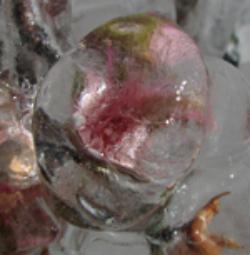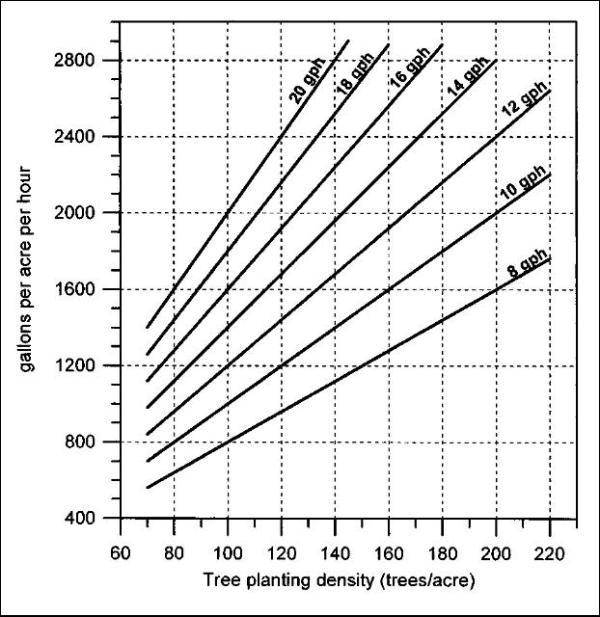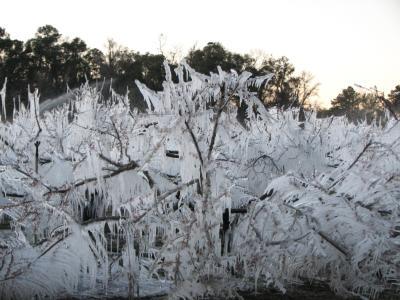Frost Protection
 Peach buds, flowers, and fruit can be damaged by late spring frosts. Peach flower buds that have just begun to swell can withstand temperatures to about 20°F. Open blossoms show injury at about 26°F. Following petal fall, the young fruit generally is killed by minimum temperatures of 28°F. However, using overhead irrigation for freeze protection can prevent such damage. A general bud hardiness guide has been developed with applicability to temperate growing areas.
Peach buds, flowers, and fruit can be damaged by late spring frosts. Peach flower buds that have just begun to swell can withstand temperatures to about 20°F. Open blossoms show injury at about 26°F. Following petal fall, the young fruit generally is killed by minimum temperatures of 28°F. However, using overhead irrigation for freeze protection can prevent such damage. A general bud hardiness guide has been developed with applicability to temperate growing areas.
The principle underlying the use of overhead irrigation for freeze protection is that heat lost from the trees is replaced by heat released as applied water turns to ice. As long as water is applied continuously at an adequate rate and is freezing, plant temperature will remain at or near 32°F. In more specific terms, when one pound of water freezes, 144 British Thermal Units (BTUs) are released. If the irrigation rate is not high enough, evaporative cooling may occur lowering plant temperature. Precipitation or irrigation rates needed for freeze protection at varying temperatures and wind speeds are listed in Table 1. Freeze protection with overhead irrigation is generally not recommended if the wind speed is greater than 10 mph.
Table 1. Precipitation rate in inches per hour needed for freeze protection at varying temperatures and wind speeds.
Source: Gerber, J. F. and J. D. Martsolf. 1965. Protecting citrus from cold damage. Univ. Fla Ext. Cir. 287.
| Dry Leaf Temperature (ºF) | Wind Speed (mph) | |||||
| 0 - 1 | 2 - 4 | 5 - 8 | 10 - 14 | 18 - 22 | 30+ | |
|
Acre-inches per hour needed for freeze protection |
||||||
| 27 | 0.10 | 0.10 | 0.10 | 0.10 | 0.20 | 0.20 |
| 26 | 0.10 | 0.10 | 0.14 | 0.20 | 0.40 | 0.60 |
| 24 | 0.10 | 0.16 | 0.30 | 0.40 | 0.80 | 1.60 |
| 22 | 0.12 | 0.24 | 0.50 | 0.60 | 1.20 | 1.80 |
| 20 | 0.16 | 0.30 | 0.60 | 0.80 | 1.60 | 2.40 |
| 18 | 0.20 | 0.40 | 0.70 | 1.00 | 2.00 | 3.00 |
| 15 | 0.26 | 0.50 | 0.90 | 1.30 | 2.60 | 4.00 |
| 11 | 0.34 | 0.70 | 1.20 | 1.70 | 3.40 | 5.00 |

Source: L. Parsons and B. Boman. 2003. Microsprinkler Irrigation for Cold Protection of Florida Citrus.
 A properly irrigated orchard will coat the entire tree in ice. Careful monitoring is necessary to ensure that a layer of ice continually forms. If the irrigation stops for any reason (e. g., blocked sprinkler, breaks in irrigation lines), damage can be more severe than if irrigation was not applied at all. Successive layers of ice can result in severe damage to the tree in the form of limb breakage and loss of scaffolds. In years with successive freeze events, retraining of these scaffold limbs will be necessary as shoots emerge through the growing season.
A properly irrigated orchard will coat the entire tree in ice. Careful monitoring is necessary to ensure that a layer of ice continually forms. If the irrigation stops for any reason (e. g., blocked sprinkler, breaks in irrigation lines), damage can be more severe than if irrigation was not applied at all. Successive layers of ice can result in severe damage to the tree in the form of limb breakage and loss of scaffolds. In years with successive freeze events, retraining of these scaffold limbs will be necessary as shoots emerge through the growing season.
Proper site selection is one of the most important factors in preventing frost and freeze damage. Cold air drainage is particularly important when radiation frost or freeze events occur. Radiation freezes occur on calm, clear nights when warm air rises and cold air settles in low areas. In these cases, the addition of wind machines can help, as well as constant irrigation during freezing temperatures.
Advective freezes can occur on cloudy or clean nights and are often characterized by windy conditions (>10 mph). In this case, strong northerly winds usher in cold air following the passage of a cold front. The windy conditions keep the air uniformly mixed and there are little differences cold or warm air above the orchard.
- Forecasting Freezes in Florida - Intellicast.com
